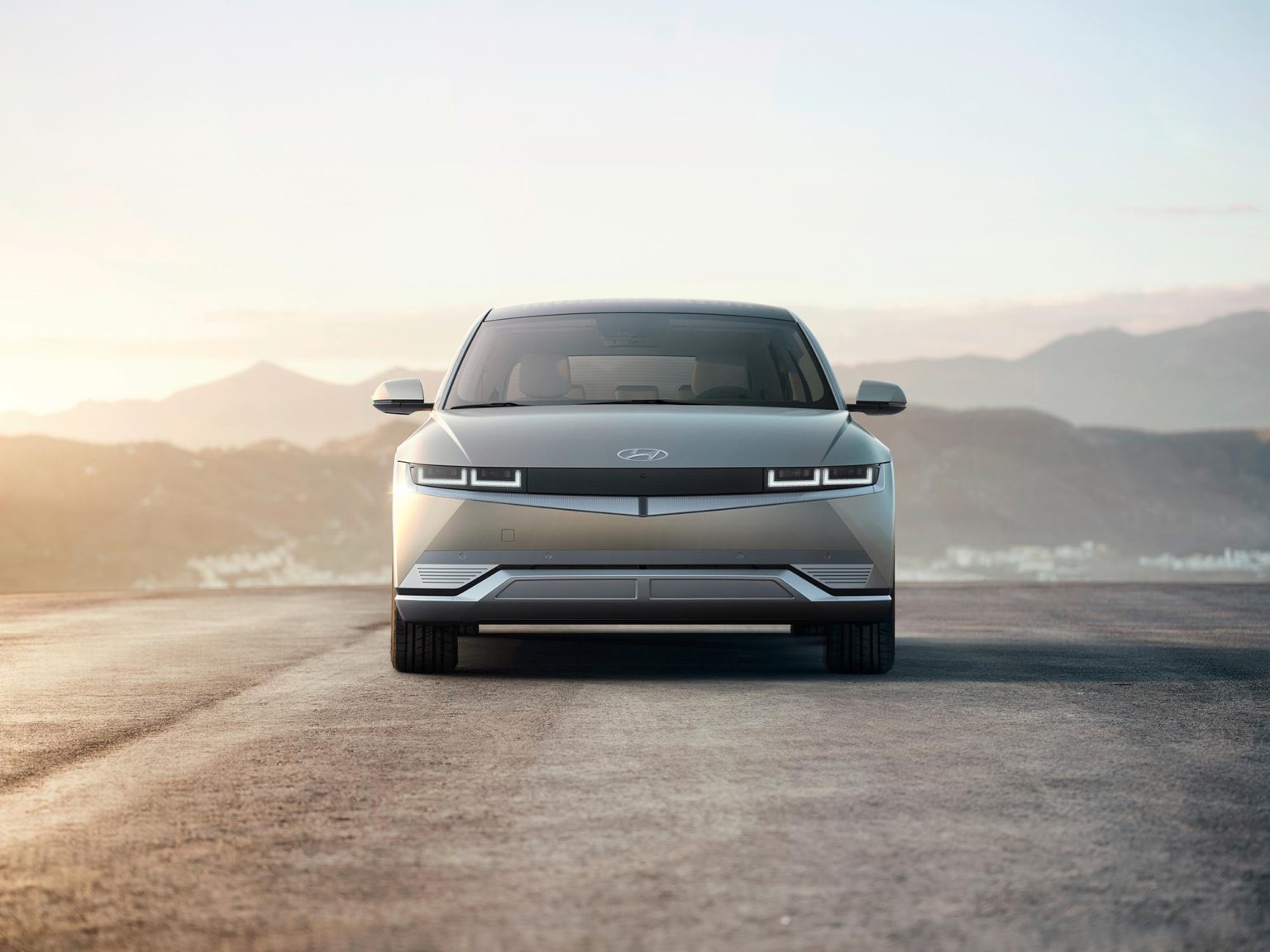The newest member of the Hyundai family brings with it the prestige of also being the first of at least three all-electric vehciles that will wear the Ioniq name and be on-sale in the coming years. The 2022 Hyundai Ioniq 5 battery electric vehicle (BEV) redefines the company’s EV strategy, making models solely for EV purposes rather than modifying internal combustion engine cars and SUVs for EV power.
The car is built on Hyundai’s dedicated BEV architecture called the Electric-Global Modular Platform (E-GMP). The new underpinnings allow the Ioniq 5 to be uniquely sized compared to Hyundai’s other vehicles. It’s six inches longer than the Tucson but four shorter than the Santa Fe. Its width is nearly the same as the Santa Fe, but it’s four inches shorter. The CUV’s wheelbase is four inches longer than the three-row Hyundai Palisade‘s.
The Ioniq is smaller than the Santa Fe but larger than the Tucson.Photo courtesy of Hyundai Motor Group
The exterior of the car features a clamshell hood that rests above unique daytime drumming lights. Small, pixel-like clusters are at the rear of the car as taillights.There are design nods to the 2022 Hyundai Tucson and Hyundai’s ’45’ concept car in the company’s exterior styling choices. The car is offered with aero-optimized 20-inch aerodynamic wheels and has a solar panel roof similar to the one on the Hyundai Sonata Hybrid.
Hyundai will sell the two-row model in four configurations offering Standard Range or Long Range models equipped with rear- or all-wheel drive. The Standard Range RWD model has a 58-kilowatt-hour lithium-ion battery pack below the floor of the car. It paired with a 160-kilowatt motor that sits on the rear axle of the vehicle. Total power output is 250 horsepower and 258 pound-feet of torque. Hyundai says that this model gets from zero to 60 mph in 8.5 seconds but it’s quicker above 60 mph.
The Standard Range AWD model adds a motor to the front axle giving the car an output of 235 horsepower and 446 pound-feet of torque.
Which part of the work you’re in will determine what the capacity is for the Ioniq 5 Long Range models. In North America, the larger 77.4 kilowatt-hour battery will be offered. Globally, a 72.6-koliwatt-hour battery pack will be sold in Long Range models. There, it is paired with the same motor setup as in the Standard Range RWD CUV to deliver about 300 miles of range per charge on the WLTP testing cycle.
The Long Range AWD model gets a more powerful front motor than the one offered in the similar Standard Range AWD setup allowing output to climb to 306 horsepower and 446 pound-feet of torque. It can get from zero to 60 mph in 5.2 seconds.
The Ioniq 5 employs the latest charging technology. It can be plugged in using a standard J1772 combined charging system (CCS) port that will rapidly charge at up to 350 kilowatts. At that speed, the Ioniq 5 can charge from 10 to 80 percent in 18 minutes. Plugging in for five minutes can give up to 62 miles of range. Charging times for other speeds has not yet been released.
Like the Ford F-150 Hybrid, the Ioniq offers a power source that camping equipment, electric bicycles, computers, and tailgating equipment can be plugged into. There’s a separate battery for that with an output of 3.6 kilowatts – about half as strong as the F-150’s most powerful option, but 70 percent more than the standard 2.1 kilowatt unit in the truck.
Unlike many hybrids and EVs on the market today, Hyundai is giving its Ioniq 5 a towing rating estimated at over 3,500 pounds.
Hyundai has given the car a movable center island that can be maneuvered forward and aft about 5.6 inches. It paired with electronically adjustable front seats that are able to recline. Front seats are not as thick as they traditionally are, allowing rear seat passengers to have more legroom.
Many of its interior touchpoints – seats, headliner, door trim, floor and armrest – use eco-friendly, sustainably sourced materials, such as recycled PET bottles, plant-based (bio PET) yarns and natural wool yarns, eco-processed leather with plant-based extracts, and bio paint with plant extracts.
Customers can choose from nine exterior colors, while the interior is offered in three color schemes.
In front of the driver is a 12-inch, customizable digital gauge cluster and an augmented reality head-up display. The car’s 12-inch infotainment screen can also be customized.
One of the highlights of the Ioniq 5’s body style, aside from the option for more passenger space, is the impressive cargo space. It has slightly less than a Subaru Crosstrek when the seats are upright and slightly more when the 60/40 split-folding rear seat is folded flat. At the front of the car is small trunk that can fit a charging cord and little else.
Each Ioniq is equipped with Hyundai SmartSense, the company’s advanced driver assistance system (ADAS). The car will be the first Hyundai model to offer Highway Driving Assist 2. It will also have forward collodion warning, blind spot warning and assist, Intelligent Speed Limit Assist, driver attention warning, and automatic high beam headlights.
Look for the first deliveries of the Ioniq 5 to start this summer. Timing for U.S. deliveries is to-be-announced.
2022 Hyundai Ioniq 5
Photo courtesy of Hyundai Motor Group
2022 Hyundai Ioniq 5
Photo courtesy of Hyundai Motor Group
2022 Hyundai Ioniq 5
Photo courtesy of Hyundai Motor Group
2022 Hyundai Ioniq 5
Photo courtesy of Hyundai Motor Group
2022 Hyundai Ioniq 5
Photo courtesy of Hyundai Motor Group
2022 Hyundai Ioniq 5
Photo courtesy of Hyundai Motor Group
2022 Hyundai Ioniq 5
Photo courtesy of Hyundai Motor Group
2022 Hyundai Ioniq 5
Photo courtesy of Hyundai Motor Group
2022 Hyundai Ioniq 5
Photo courtesy of Hyundai Motor Group
2022 Hyundai Ioniq 5
Photo courtesy of Hyundai Motor Group








